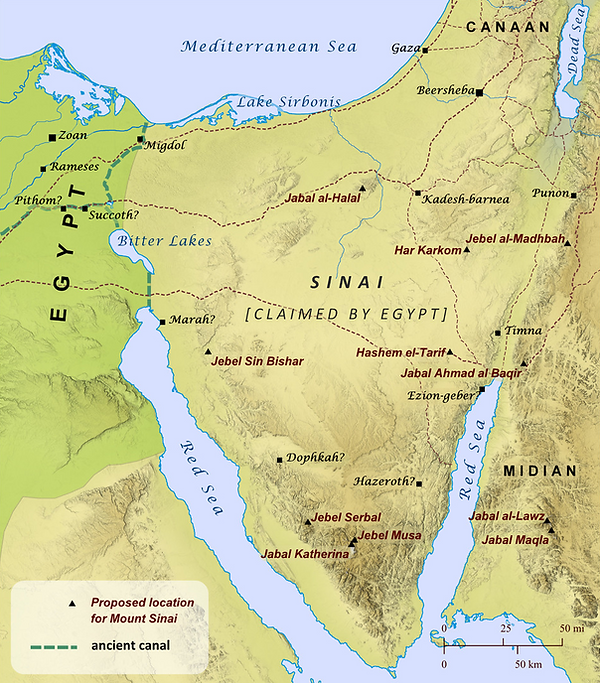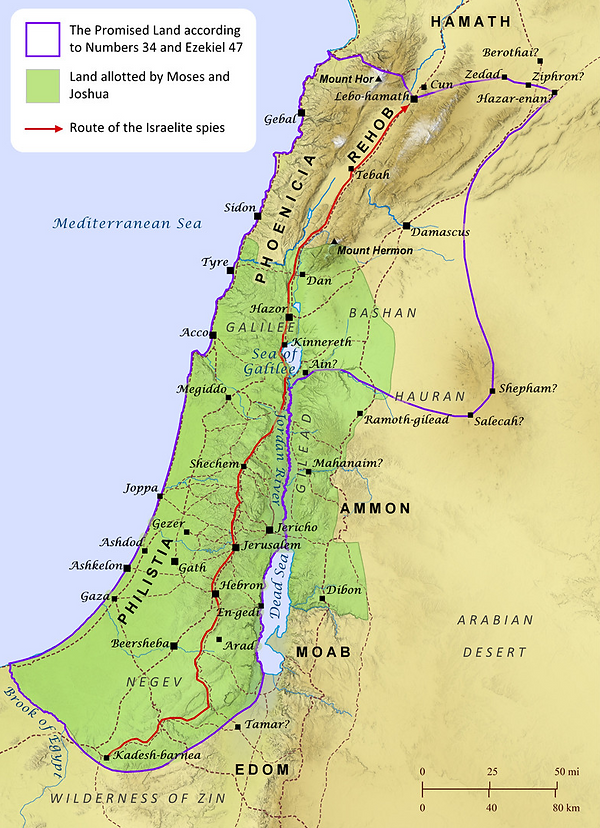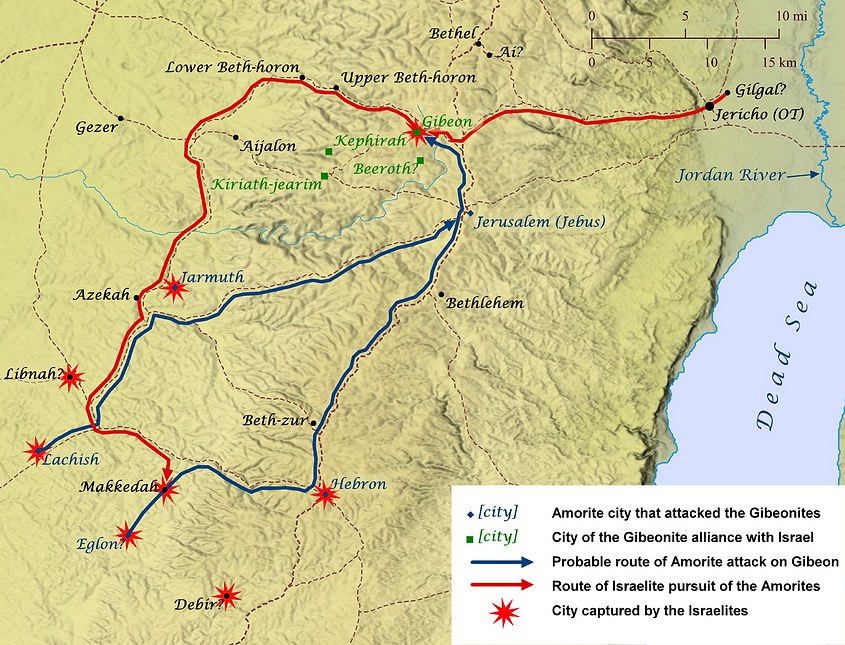
Spivey's Unauthorized Biblical Timeline
a Scripture-centered journey through God's redemptive story from a historic perspective.
So who was the Pharaoh of the Exodus? There are many theories about Egyptians chronology and after reviewing materials from Dr. Douglas Petrovich and Joel Kramer, a biblical archaeologist, I believe that they have correctly identified (from an academic perspective) Amenhotep II as the Pharaoh of the Exodus.
Dr. Petrovich has re-calibrated the Egyptian chronology of the 18th Dynasty (as outlined in his book "Origins of the Hebrews, New Evidence of Israelites in Egypt from Joseph to the Exodus") to reflect the dates in the graph above. This amendment correctly aligns with the biblical text that shows:
-
Thutmose I was the new king that did not know Joseph and ordered the murder of all boys under 2 years old.
-
Hatsheput was the 19 year old daughter of Thutmose I that drew Moses out of the water and raised him as a royal. She married her younger brother, Thutmose II and continued to raise Moses in the royal family. When she became Pharaoh and co-ruled under her nephew/stepson Thutmose III came of age, it is Thutmose III that was the Pharaoh that tried to kill Moses for killing the Egyptian soldier. One can understand how much Hatsheput loved Moses and would try to protect him. It may partially explain why Thutmose III would go to such lengths to erase Hatsheput from much of Egyptian history written in stone. Moses fled to Midian.
-
Amenhotep II was Pharaoh when God commanded Moses to returned to Egypt and lead the Hebrews on a journey to the promised land.
-
Following the Exodus event, Amenhotep II conducted a 2nd and final campaign in November (not a typical time for going to war) and instead to plunder, he recorded the capture of 100,000 slaves/warriors and 15,000 chariots in order to replenish the losses in labor and military forces. Over 17 campaigns, Thutmose III gathered a total of about 8,800 captives, in comparison.
-
Thutmose IV was not the first-born son of Amenhotep II.
Why is Amenhotep II the most likely candidate? Dr. Petrovich provides an excellent outline of the criteria supporting Amenhotep II if his previously reference book:
-
Flavius Josephus, Against Apion, extra-biblical texts that refuted other historians accounts of the interactions of the Hebrews with Gentile nations, yet writings are embraced and utilized by academia.
-
Line No. 230-231: "230 for he [Manetho] mentions Amenophis [Amenhotep II], a fictitious king’s name, though on that account he durst not set down the number of years of his reign, which yet he had accurately done as to the other kings he mentions; he then ascribes certain fabulous stories to this king, as having in a manner forgotten how he had already related that the departure of the shepherds for Jerusalem had been five hundred and eighteen years before; 231for Tethmosis [Tuthmose IV] was king when they went away.
-
Manetho - an Egyptian Priest that lived around 300 BC. He was commissioned to decipher and compile the hieroglyphics of Egyptian history into Greek and called his compilation the Aegyptiaca (History of Egypt). A complete book has not survived, only portions from many sources.
-
-
Line No. 240: "240 When he had made such laws as these, and many more such as were mainly opposite to the customs of the Egyptians, he gave order that they should use the multitude of the hands they had in building walls about their city, and make themselves ready for a war with king Amenophis, "
-
Line No. 245-247: 245 ... Yet did he not join battle with them; 246 but thinking that would be to fight against the gods, he returned back and came to Memphis, where he took Apis and the other sacred animals which he had sent for to him, and presently marched into Ethiopia, together with his whole army and multitude of Egyptians; for the king of Ethiopia was under an obligation to him, 247on which account he received him, and took care of all the multitude that was with him, while the country supplied all that was necessary for the food of the men. He also allotted cities and villages for this exile, that was to be from its beginning during those fatally determined thirteen years. Moreover, he pitched a camp for his Ethiopian army, as a guard to king Amenophis, upon the borders of Egypt."
-
Line No. 289-290: "288 And now I have done with Manetho, I will inquire into what Cheremon [Chaeremon] says; for he also, when he pretended to write the Egyptian history, sets down the same name for this king that Manetho did, Amenophis, as also of his son Ramesses, 289and then goes on thus:—“The goddess Isis appeared to Amenophis in his sleep, and blamed him that her temple had been demolished in the war: but that Phritiphantes, the sacred scribe, said to him, that in case he would purge Egypt of the men that had pollutions upon them, he should be no longer troubled with such frightful apparitions. 290 That Amenophis accordingly chose out two hundred and fifty thousand of those that were thus diseased, and cast them out of the country: that Moses and Joseph were scribes, and Joseph was a sacred scribe; that their names were Egyptian originally; that of Moses had been Tisithen, and that of Joseph, Peteseph:"
- Chaeremon - a Stoic philosopher and historian from Alexandria who lived in the 1st Century and wrote on Egyptian history.
-
-
Bible References
-
Exodus 1:8 explains that a new king [Thutmose I], who did not know about Joseph, came to power in Egypt. Thutmose I was a commoner not of the royal-decent; never referencing himself as the son of the king. He ascended to the rank of general in the army of Amenhotep I.
-
Exodus 1:9-14 states he oppressed the Hebrews and prescripted them to forced labor building many projects, including the famous Temple of Karnak.
-
Exodus 2:1-10 is the narrative where the Pharaoh's daughter heard Moses crying in the basket as it floated in the Nile River. He was retrieved and adopted him as her son.
-
Exodus 2:11-15 recalls how Moses killed an Egyptians for beating a Hebrew. Once the Pharaoh heard, he (a male) tried to kill Moses so Moses fled to Midian. Moses was the offical "son" of Hatsheput, who never conceived a male heir and was co-regent with her stepson/nephew Thutmose III. She was 60 years old, Moses was 40 years old and Thutmose III was 20 years old at this time. Thutmose III was not sole ruler until 1483 BC, after Hatsheput's death. On theory is that Thutmose III was so upset by this relationship that it was one factor in his campaign to erase much of her history written in stone throughout Egypt.
-
Acts 7:20-29 relates the Moses was adopted as a son and "educated in all the wisdom of the Egyptians and was powerful in speech and action."
-
-
Exodus 2:23-25 shows that Pharaoh died after a long period of time and the Hebrews continued to suffer. Thutmose III co-ruled from 1504 BC to 1484 BC (22 years) then was sole ruler from 1483 BC to 1450 BC (34 years) totaling 56 years. He died 36 years after Moses fled to Midian then his son, Amenhotep II ruled in 1453 BC.
-
Exodus 12:29-30 reflects the result of the 10th plague, which killed the first-born of everyone who did not follow God's instructions so that the Destroyer would "pass over" the house. The Pharaoh's first-born was killed. Neither Amenhotep II nor his son Thutmose IV were first-born.
-
The Dream Stele was erected by Thutmose IV and placed between the paws of the Great Sphinx. It stated that Thutmose IV usurped the throne from his older brother.
-
Joel Kramer video: Tomb of the Exodus Pharaoh: What Was Found & Why You Don't Know About It!
-
-
Exodus 12:31-39 says the Pharaoh commanded the Hebrews to leave immediately; about 600,000 men or over 2,000,000 with families. Dr. Manfred Bietak, chief excavator of Tell el-Dab’a [Avaris], made a statement about the Ahmose I campaign against the Hyksos that “there is mounting evidence to suggest that a large part of this population stayed in Egypt and served their new overlords in various capacities”.
Another archaeologist, Dr. Scott Stripling is cited in his study of Dr. Bietak's work called Five Views on the Exodus: Historicity, Chronology and Theological Implications that “Bietak’s stratigraphic analysis [of Tell el-Dab’a] reveals a clear abandonment in the mid-18th Dynasty, during or after the reign of Amenhotep ii. … [T]he latest identifiable pottery dates to the reign of Amenhotep ii. … Much of Avaris Stratum d/1 (in Area F/I) to Stratum c (Area H/I-VI) points to the presence of a Semitic population until the mysterious abandonment.” -
Exodus 14:1-31 gives an overview of how the Pharaoh and his army pursued the Hebrews. Eventually, the entire army of the Pharaoh was destroyed (not including the Pharaoh). This would have taken place in April/May of 1446 BC.
-
-
Battle Campaigns - Unlike his father, Thutmose III who had 17 military campaigns throughout the Levant and Nubia, Amenhotep only had two (2) major campaigns. There are several stele that record his campaigns (Memphis, Karnak, Amada and Elephantine).
-
1450 BC - (Spring) against massive revolt in Syria upon death of his father, Thutmose III.
-
1446 BC - (Winter) The loot was recorded as 101,128 slaves, 1,082 chariots, and 13,500 weapons. He also signed a peace treaty with the Mitanni.
-
-
Other
-
Doug Petrovich video: The Chronology of the the Exodus Event at Chafer Theological Seminary 2023
-
The Soleb Inscription: The Soleb Inscription: Earliest-Discovered Use of the Name ‘Yahweh’ by Jude Flurry on October 10, 2022; Armstrong Institute of Biblical Archeology
-
MOSES
Moses' life can be divided into three divisions: 1st 40 years: Egyptian; 2nd 40 years: Midian; 3rd 40 years: Hebrew
-
mose/mosi (Egyptian verb) means “to give birth” or "is born"
-
mose (Egyptian related noun) means “child” or “son”
-
mesen (Egyptian verb) means “brought forth of water”
-
Mosheh (Hebrew) "מֹשֶׁה" means "to draw out"
-
Moses (Greek) "Μωυσῆς"
-
17th / 18th Dynasty names of their Pharaohs
KA M O S E ("the soul 'ka' is reborn")
AH M O S E I (“the moon god 'Ah' is born”)
AMENHOTEP I - SON OF AHMOSE I
THUT M O S E I (“the god of intelligence 'Thoth' is born”)
M O S E S (“is born”)
THUT M O S E II (“the god of intelligence 'Thoth' is born”)
HATSHEPUT - (REGENT/MOTHER OF THUTMOSE III)
THUT M O S E III (“the god of intelligence 'Thoth' is born”)
-
Website - Moses Name in Hieroglyphics
-
Website - Moses Name in Hebrew
-
Website - Bible Odyssey name of Moses
AS EGYPTIAN: Born to Amram [3rd son of Jacob, Royal Priesthood] and Jochebed, who were both Levites, he was born under the edict of the Pharaoh [Thutmose I] that all boys who were born must be thrown into the Nile. When he could no longer be hidden, Jochebed made an ark [papyrus basket with tar and pitch] and place him in the Nile, in the hands of God, as his sister Miriam watched. The Pharaoh's daughter [Hatsheput] heard the cries and the baby was retrieved. She knew he was Hebrew, but she kept him anyway and called him "Mose". Miriam offered to find a wet nurse [Jochebed, his mother] and the Hatsheput agreed. Once old enough, he lived in the Pharaoh's house [Thutmose I, Thutmose II and co-regency of Hatsheput/Thutmose III] and was taught all the knowledge of Egypt. When he was 40 years old, he killed an Egyptian that was beating a Hebrew. Upon hearing of the death, the Pharaoh [Thutmose III at the age of 20] sought to kill Moses, probably fearing a revolt, since he knew that Moses was born a Hebrew. Moses fled into the desert, probably by the Way of the Wilderness trade route that ran diagonally to the tip of the Gulf of Aqaba and into the Land of Midian.
There are many similarities between Moses in the Holy Bible and Senenmut from Egyptian history, who was an non-royal that rose to great position and influence under Hatsheput's rule. (see article link). Senenmut had favor with Hatsheput, becoming the tutor for Hatsheput's daughter Neferure, leading a military campaign in Nubia, was the lead architect of her famous Mortuary Complex and had two personal tombs built that were never used. His last appearance in official records was in the 16th year of the co-regency [1490 BC]. Both he and Hatsheput were subjected by Amenhotep II to a campaign that tried to erase them from Egyptian history.
As another side note, Neferure also disappeared from official records around the same time and it is thought that she is the biblical name "Bithiah" from 1 Chronicles 4:17-18 "17 The sons of Ezrah: Jether, Mered, Epher and Jalon. One of Mered’s wives gave birth to Miriam, Shammai and Ishbah the father of Eshtemoa. 18 (His wife from the tribe of Judah gave birth to Jered the father of Gedor, Heber the father of Soko, and Jekuthiel the father of Zanoah.) These were the children of Pharaoh’s daughter Bithiah, whom Mered had married." This would mean that she left during the Exodus with Moses and the Israelites.
AS MIDIANITE: Genesis 25:1-2 describes the sons of Abraham by his other, Keturah (after the death of Sarah). She bore several sons, of which one was named Midian. Genesis 37:26-36 tells of Joseph's brothers selling him to Midianite merchants, who in turn sold him to Potiphor in Egypt. Moses found a well at the end of his journey. He rescued some girls who were being bullied by some shepherds. They noticed that he looked Egyptians and told their father, Reuel "friend of God", a priest of Midian also known as Jethro, "his excellency", and a title of honor. He married the daughter, Zipporah, had two children and became a shepherd for Jethro. At the age of 80, Exodus 3 says the angel of the Lord (Pre-incarnate Jesus) met Moses on Mt. Horeb (Jebel al-Lawz in Saudi Arabia) in flames of fire within a bush, although the bush was not burnt. God told Moses to bring the Hebrews out of Egypt and come back to Mt. Horeb to worship him. God also send Moses' brother, Aaron, to meet Moses at Mr. Horeb.
Time of the Exodus and Conquest of Promised Land
AS HEBREW: Moses went back to Egypt not as an Egyptian or Midianite, but as a fellow Hebrew. He spoke with the Hebrew elders and with Pharaoh. God displayed his mighty power to the Egyptians and their false gods, and to the Hebrews in fulfilling his promise to deliver them from Egypt back to Canaan. Two years after leaving Egypt, God led them to the Promised Land. They sent 12 spies to search the land, 10 of the 12 were to scared. Only Joshua and Caleb believed God would fight for them and deliver the Canaanite people into their hands. Because the their disobedience, God made them wander the Wilderness for 38 more years until everyone over 20 in the 10 tribes that disobeyed had died. Even Moses, in a separate act of disobedience, lost is chance to go into the Promised Land. At the age of 120, God brought the Hebrews (Israelites) back to Canaan where Moses turned over leadership to Joshua and gave final instructions to the Israelites to obey God.
Note about the death of Moses:
1. The Lord [Pre-incarnate Jesus] buried Moses in Moab (Deuteronomy 34:1-6)
2. Satan fought with the Archangel Michael for the body of Moses (Jude 9)
3. Elijah and Moses may be the identity of the two witnesses in Revelation 11 (Exodus 7:14-11:10; 1 Kings 17:1, 18:16-46; 2 Kings 1:1-15, Matthew 17:1-13; Mark 9:2-13; Luke 9:22-25)
1526 BC - Moses was born
-40
1486 BC - Moses kills Egyptians and flees to Land of Midian
-40
1446 BC - Moses returns to Egypt and leads people to Mt. Horeb
-02
1444 BC - 12 spies sent in Canaan. 10 have a bad report.
-38
1406 BC - Journey to Promised Land. Moses dies. Joshua leads Israel.
-07 War with inhabitants of Canaan and surrounding nations.
1399 BC - Promised Land rests from war
-40
1359 BC - Joshua dies. Generation that obeyed God. (Judges 2:6-9)
-40
1319 BC - Generation that forgot God (Judges 2:10-13)







